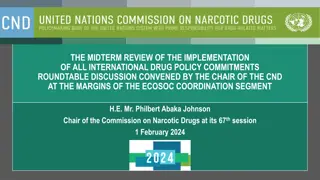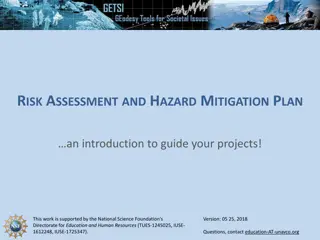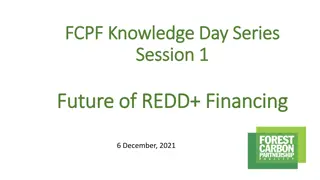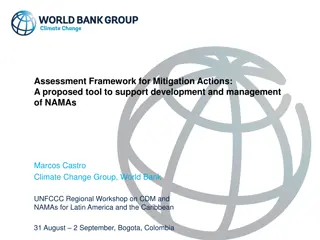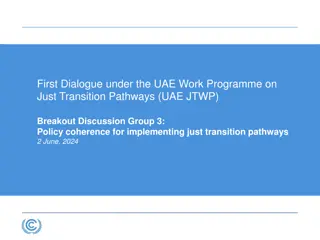Tracking Progress of Mitigation Commitments in NDCs
This presentation by Dr. Aiymgul Kerimray explores the GACMO model, a tool for developing economy-wide GHG emissions projections and tracking mitigation efforts. Learn how GACMO calculates GHG reductions, costs, and scaling of mitigation options. Discover steps to develop the GACMO model and input data needed for analysis. Explore available mitigation options within the GACMO tool, from rice crop CH4 reduction to biomass power generation.
Download Presentation

Please find below an Image/Link to download the presentation.
The content on the website is provided AS IS for your information and personal use only. It may not be sold, licensed, or shared on other websites without obtaining consent from the author.If you encounter any issues during the download, it is possible that the publisher has removed the file from their server.
You are allowed to download the files provided on this website for personal or commercial use, subject to the condition that they are used lawfully. All files are the property of their respective owners.
The content on the website is provided AS IS for your information and personal use only. It may not be sold, licensed, or shared on other websites without obtaining consent from the author.
E N D
Presentation Transcript
Tracking Progress of the Mitigation Commitments of Nationally Determined Contributions (NDCs) Dr Aiymgul Kerimray Presentation: Supporting tools to develop economy wide GHG emissions projections: GACMO Mitigation specialist UNEP Copenhagen Climate Centre
What is GACMO Model GACMO = Greenhouse gas Abatement Cost Model Bottom-up modelling tool for greenhouse gas emissions based on Excel IPCC / CDM Methodologies Developed by J rgen Fenhann at UNEP CCC GACMO tool - UNEP-CCC (unepccc.org) Available for free on the UNEP CCC website GACMO tool - UNEP-CCC (unepccc.org)
GACMO is a simple tool GACMO is a simple tool The tool should be able to make Business As Usual (BAU) projection to:2025/2030/2035/2050 GACMO can make a NDC with a reduction of a percentage reduction of the GHG emission compared to the BAU. The tool should be able to calculate the GHG reduction and the cost for each mitigation option compared to the technology used in the baseline. The tool should be able to scale the size of the mitigations option up and down. The tool should give a clear overview of the total mitigation effort: total GHG reduction, total investment, and total annual cost. The calculation should be transparent and easy to follow.
Steps to develop GACMO model Steps to develop GACMO model
BAU scenario Total GHG emissions GHG emissions from non- energy sectors CO2 Non-CO2 emissions from energy sector GHG emissions from fuel combustion emissions in BAU scenario
Input data for GACMO Growth rates of energy consumption by sectors GHG emissions inventory by sectors Energy Balance Emission factors (same year as GHG emissions inventory year). (if national emission factors are available). (annual % change up to 2025, 2030, 2035 and 2050). (latest available year). Technical and economical parameters of the technology/mitigation options (new technology and baseline technology). Key assumptions Mitigation actions by 2025, 2030, 2035, 2050. (e.g. grid emission factor, energy prices, etc.).
Mitigation options in GACMO Annex. Mitigation options available in the GACMO tool Type Reduction option Rice crop CH4 reduction Zero tillage Cover crops Nitrification inhibitors (1000 ha) Covering slurry stores (1 slurry store) Fat supplementation in ruminants diets (%DM fat added) %DM fat added Tobacco curing Rice husk cogeneration plants Biomass power from biomass residues Bagasse power CCS plant Clinker replacement Coal mine methane Efficient residential airconditioning Efficient lighting with CFLs Efficient lighting with LEDs Efficient lighting with LEDs replacing CFL Efficient wood stoves Efficient charcoal stoves LPG stoves replacing wood stoves Efficient electric stoves Induction based cooking New passive home Efficient refrigerators Sub-type unit Rice crop CH4 red.(1000 ha) 1000 ha 1000 ha 1000 ha 1 slurry store Agriculture There are 119 pre-defined mitigation options available in GACMO The user can select and adjust mitigation option applicable for the country 100 t tobacco/yr 1 MW cogeneration 1 MW CHP plant 100 kt sugar cane/year 1 MW 1000 tonnes cement/day 10 Mm3 CMM/year 1000 Airconditioners 1000 Bulps 1000 Bulps 1000 Bulps 1000 stoves 1000 stoves 1000 stoves 1000 stoves 1000 stoves 1000 new homes 1000 refrigerators Biomass energy CCS Cement Coal bed/mine methane EE households
Approach for the calculation of emission reduction for a mitigation option Example of efficient lighting LED lamps replacing incandescent light bulbs Emissions in reference option (incandescent light bulbs) Emissions in reduction option (LED lamps) Emission reduction from mitigation measure
Approach for the calculation of emission reduction for a Approach for the calculation of emission reduction for a mitigation option mitigation option
GACMO summary table for the 22 GHG GACMO summary table for the 22 GHG mitigation options in the Maldives mitigation options in the Maldives Investment Annualized Emission reduction in 2020 costs MUS$ MUS$/year 0.0 -0.8 0.0 -10.0 4.7 -12.7 1.8 -4.6 0.7 -0.8 9.6 -27.7 0.1 -0.6 61.1 -11.2 42.4 -3.7 10.4 -2.2 42.0 -2.2 41.2 -6.6 45.0 -2.1 45.0 -2.1 14.5 -0.9 167.4 -6.3 97.3 -2.8 57.8 -1.6 167.1 -1.8 42.4 1.7 0.0 71.6 0.0 4.9 850.3 -22.6 Mitigation options Abatement costs US$/tonCO2 Unit Type Emission reduction penetrating t CO2/unit 0.015 24304 0.87 0.046 24 1.19 1505 43199 1.22 9535 1.13 0.51 1.05 1.05 0.10 1.22 26502 23061 1.2 8467 213000 14637 Totals Million US$ Units Per option kt/year Cumulative fracion in 2020 70,000 LED tubes for public sector Better maintenance of motor bikes Air conditioning at resorts Cooling new service buildings Solar water heater Efficient air conditioning LED tubes for street light Upgrade of system efficiencies PVs outer islands Regional waste-to-energy projects PVs with Net Meters Energy efficient refrigerators PVs Mal Region (existing plans) PVs Mal Region (additional options) Efficient water pumping PVs on resorts 20 MW wind power & 25 MW LNG Thilafushi waste-to-energy project PVs with storage at small islands LEDs for domestic lighting Biodiesel 20% blend Bioethanol 15% blend -784 1 light tube replaced -413 All motor bikes -398 1 Aircondinioner -369 1 m2 -323 1 unit -313 1 Airconditioner -292 2200 street lights -260 All eligible Islands -252 1 kW -228 100 ton/day of waste -189 1 kW -158 1 refrigerator -133 1 kW -133 1 kW -117 1 household -108 1 kW -105 45 MW -68 A 4 MW plant -52 1 kW 199 All domestic bulps 336 20% blend 337 15% blend 1.1 24.3 31.8 12.4 2.5 88.5 2.2 43.2 14.7 9.5 11.9 42.0 15.8 15.8 7.6 58.2 26.5 23.1 35.3 8.5 213.0 14.6 702.4 0.1% 1.3% 2.9% 3.5% 3.7% 8.2% 8.3% 10.5% 11.2% 11.7% 12.3% 14.4% 15.2% 16.0% 16.4% 19.4% 20.7% 21.9% 23.7% 24.1% 34.9% 35.7% 35.7% 1 36,467 270,336 102 74,186 1.48 1 12,100 1 10,500 82,823 15,000 15,000 72,470 47,815 1 1 29,000 1 1 1 1968 ktCO2-eq. Total baseline emission in 2020:
Results of GACMO Results of GACMO Marginal Abatement Revenue Marginal Abatement Revenue (MAR) curve for Chile (MAR) curve for Chile Marginal Abatement Revenue Curve (MARC) can be created. A MACC/MARC presents the costs or savings of the mitigation actions and expected emissions reductions from those mitigation actions. MACC/MARC can be useful tool to select mitigation actions appropriate for the country based on the emissions reductions and costs/revenues. Marginal Abatement Cost Curve (MACC) or
Mitigation options included/excluded in the MAR curve for Chile Options included in MAR Curve Emission reduction in 2030 per option kt/year Options excluded in MAR Curve Emission reduction in 2020 per option kt/year Reduction option US$/tonCO2 Reduction option US$/tonCO2 New natural gas power plant Cogeneration in industry Shifting freight transport from road to rail (1000 tonkm/day) 1562.82 Efficient electric motors Efficient residential airconditioning Efficient office lighting with LEDs Zero tillage Electric cars Efficient refrigerators Assisted forest regeneration Reforestation with Silvopasture Biogas at rural farms using non-renewable fuelwood Nitrification inhibitors (1000 ha) Fat supplementation in ruminants diets (%DM fat added) Efficient electric grids Solar tower CSP, with storage Electric trucks Electric 12m buses 2546.69 2371.03 861.00 620.50 30.17 50.16 32.13 45.74 42.86 165.27 102.94 18.33 36.67 112.74 102.70 0.77 -6863.98 3567.31 6783.28 7641.60 Efficient lighting with LEDs Hydro power connected to main grid Solar water heater, residential Solar PVs, large grid Wind turbines, on-shore Geothermal power More efficient gasoline cars Biogas from industrial waste water New bicycle lanes Mini hydro power connected to main grid REDD: Avoided deforestation Composting of Municipal Solid Waste Biogas from Municipal Solid Waste Energy efficiency in industry Landfill gas flaring Bus Rapid Transit (BRT) CCS plant 345.66 333.82 319.16 316.19 288.73 252.54 248.36 191.45 173.53 124.47 12.92 0.01 -0.26 -1.17 -1.28 -125.30 -164.50 504.25 8377.52 289.72 6298.99 11900.00 8753.50 727.85 393.39 2059.75 5298.00 4400.00 1158.30 1949.88 3759.38 1866.23 493.88 4811.00 296.40 295.26 255.18 198.80 118.82 32.65 4.81 0.87 -2.84 -67.69 -80.50 -185.27 -374.07 -615.93 -965.37 Threshold for smallest value on x-axis (ktCO2e/yr) Threshold for smallest value on y-axis (US$/ktCO2e) Threshold for largest value on y-axis (US$/ktCO2e) 200 -200 800
Results of GACMO: Results of GACMO: GHG emissions GHG emissions projections in BAU and projections in BAU and Mitigation scenario Mitigation scenario Example of use of GACMO for NDC for Lao PDR
Conclusion Conclusion
Thank you! Aiymgul Kerimray aiymgul.kerimray@un.org

